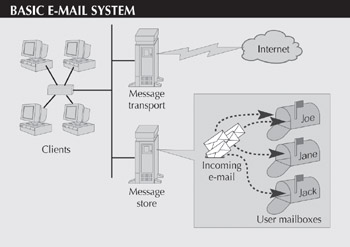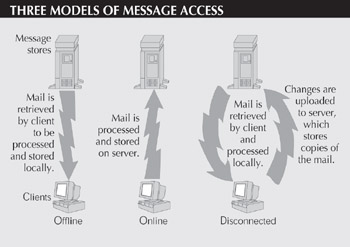The Basics of E-Mail Access
| |
SMTP transports e-mail across the Internet; POP-3 and IMAP-4 deliver it to your desktop.
In the tutorial, "E-Mail and SMTP," I discussed how electronic mail travels across the Internet from your e-mail system to that of the recipient's. Simply put, e-mail relies on the Simple Mail Transfer Protocol (SMTP) to relay messages from mail server to mail server until they have reached the destination server. However, SMTP doesn't handle the transfer of mail from the mail server to the desktop.
In this tutorial, I'll discuss the last leg of the journey: how users access e-mail on their mail server from their client machines. There are a few different models for this operation and a few different protocols that can handle the task, including proprietary protocols found in commercial e-mail packages and two Internet standards-based protocols, Post Office Protocol3 (POP-3) and the Internet Message Access Protocol 4 (IMAP-4).
Companies usually employ proprietary e-mail packages to handle local e-mail operations, but standards-based systems are appealing. One, you can avoid the go-between, in this case a proprietary system, by having clients work directly with your mail server. Two, you can avoid having to install gateways in order to let your system communicate with the Internet. Finally, the enhanced features offered in IMAP-4 can potentially rival those found in proprietary packages, although IMAP-4 client packages are just beginning to enter the market in pretty primitive form.
What's In Store
As I mentioned, SMTP relays e-mail across a series of Internet mail servers until it reaches the designated recipient's mail server. It uses DNS tables and mail exchange records, also known as MX records, to locate the server. Once SMTP delivers the e-mail message to the final mail server, the message is placed in a message store, which is also called a post office. (If the recipient uses a proprietary e-mail system, such as cc:Mail, the e-mail is received by the product's Internet or SMTP gateway, which uses its own proprietary protocols to store the message in the post office for retrieval by the recipient.)
In its most basic form, the message store, located on a server, is usually some type of file system that holds delivered mail for access by users. You can think of the message store as one large directory with subdirectories dedicated to each user . These subdirectories are also known as mailboxes. A more advanced form of message store would allow users to create personal folders to store read and unread messages, and it would allow users to create archives for groups of messages. Other advanced features include the ability to perform keyword searches and to create a hierarchy of folders.
As a side note, the message store component of an e-mail system is usually located on a different machine than the message transport component, which handles the delivery of incoming messages and the transmission of outgoing ones. The reason for their separation is that the transport component usually handles a high volume of operations. So, if both systems were on the same machine, the traffic of inbound and outbound mail would experience a performance drag, as would users when they try to retrieve and manipulate mail in their mailboxes.
Figure 1 illustrates a basic architecture for a local e-mail system.

Figure 1: A basic local e-mail system consists of a message transport that transmits outgoing mail and delivers incoming mail to the message store, which stores mail in the appropriate user's mailbox. Users can then access their messages from their desktops using a client program that is running a message access protocol, such as POP-3, IMAP-4, or a proprietary protocol.
The Access Models
Once an e-mail message is delivered to the message store, it's ready for retrieval by the recipient. There are three basic models for message access: offline, online, and disconnected (see Figure 2).

Figure 2: The message access transaction can be divided into three models: offline, online, and disconnected. The main difference between the three revolves around where the mail is actually read or processed and where the mail is stored.
The offline model is the most basic of the three. In the offline model, a client connects to the mail server and downloads all messages designated for that particular recipient. Once downloaded, the messages are erased from the server. Then, the user processes, manipulates, and stores the messages locally at the client machine. The advantages of the offline model are obvious. It requires a minimal amount of server connect time since the client accesses the server only periodically for mail downloads. Also, because the mail processing is performed at the client, the offline model won't eat up a lot of server resources. And, it requires less server storage space because mail is deleted from the server once it has been downloaded by a client.
Of course, the offline model does have drawbacks. For instance, because mail is downloaded to a particular machine, you must use that machine to access processed mail. So, if you downloaded e-mail to your desktop computer and then went on the road with your laptop, you wouldn't be able to read those same messages off the mail server from your laptop. And, because all processing and storage is performed at the client machine, the client must be endowed with enough resources to be up to the task.
With the online model, all e-mail processing and manipulation is performed at the server. In fact, all the messages remain on the server even after they've been read by users, although in some implementations , users can save e-mail to the local client.
As you might expect, the online model requires a constant connection to the server whenever users need to access and work with their e-mail. Consequently, this model's high connect time could mean that more users are sharing bandwidth at any given time. And, because the server is burdened with all message processing and storage, you'll need a more powerful server to handle an online e-mail system than you would with an offline system.
In addition, users can't work with their e-mail unless they are online, meaning they must be at a client that can access the mail server even to do the simplest task, such as reread an old message.
However, because all mail is stored and processed at the server, you can access your e-mail from any client that can connect to the server. For the same reason, this model requires fewer resources at the client machine. And, online-type systems usually offer enhanced features such as the ability to create a multitude of personal folders to organize e-mail, and the ability to create archives for storing messages.
The disconnected model combines elements of both the offline model and the online model. Using this system, a user connects to a mail server to retrieve and download e-mail. Then, the users can process the mail on the local client.
Once the user is finished with the messages, the user once again connects to the mail server and uploads any changes. With this model, the mail server acts as the main repository of the user's e-mail.
The disconnected model's strengths are that users can access e-mail from a variety of clients that have access to the mail server. Users can also process mail offline. This also translates to a shorter server connect time. However, the model does require a sufficient amount of resources on both the server and the client.
A Matter Of Protocols
I mentioned earlier that proprietary e-mail packages currently dominate the business market. Most companies employ systems such as Lotus Notes, Microsoft Outlook, and Microsoft Exchange.
The majority of e-mail packages follow the online model of e-mail access. These products use their own protocols to retrieve messages from Internet mail servers and store them on local servers. Then, users can use the products' client programs to access and work with mail from message stores on the proprietary e-mail servers. The attractiveness of these proprietary packages lies in the added features they offer. For instance, they usually offer advanced mail manipulation such as folders, hierarchical folders, and archives. Some offer the ability to create bulletin board systems for general corporate communications. In addition, some offer message notification when a new e-mail arrives for a particular user. Also, they usually offer searching abilities , so users can find e- mails with particular headings, or look up the addresses of other users on the system.
The problems with these packages follow all the arguments you may have heard about relying on a proprietary solution: Mainly, you're locked into a closed system. For instance, if you want to be able to access your e-mail from a remote location, your proprietary package must support this capability. Or, let's say your SMTP gateway goes down. All outbound and inbound Internet e-mail will be blocked. If your e-mail server goes down, you won't be able to send or receive anything.
In contrast, Internet standards-based e-mail clients ought to be able to send e-mail as long as they have an Internet connection and know of an SMTP mail server that clients can use to send messages. In addition, as long as the client has an Internet connection, it ought to be able to reach your organization's Internet mail server to retrieve and process messages regardless of where the client is located or on what machine.
One of the first e-mail access protocols developed was the Post Office Protocol, the latest version of which is POP3. In essence, POP3 follows the offline model of message access, and it revolves around send-and-receive types of operation. However, there have been recent attempts to remodel POP3 so that it has some online capabilities, such as saved-message folders and status flags that display message states. But using POP3 in online mode usually requires the additional presence of some type of remote file system protocol.
IMAP-4 is the more advanced of the standards-based message access protocols. It follows the online model of message access, although it does support offline and disconnected modes. IMAP-4 offers an array of up-to-date features, including support for the creation and management of remote folders and folder hierarchies, message status flags, new mail notification, retrieval of individual MIME body parts , and server-based searches to minimize the amount of data that must be transferred over the connection.
POP3, IMAP-4 Update
Currently, there are POP3 and IMAP-4 products available on the market, although the IMAP-4 offerings are limited. This status should change, as IMAP-4 is seen as the future of Internet-based e-mail. If you're just testing the waters, you should be able to find free implementations of both types of clients available on the Internet. Mac, PC, and Unix clients should all be represented. Again, the strengths of these protocols are that they are open and Internet-oriented. So, it won't take added steps to get your e-mail system to work with the Internet. In addition, users will be able to access mail from a variety of client platforms and from a variety of locations, as long as TCP/IP is up and running and users have access to the Internet.
This tutorial, number 106, by Lee Chae, was originally published in the June 1997 issue of Network Magazine.
| |
EAN: 2147483647
Pages: 193